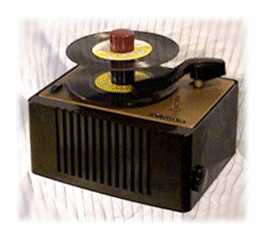

In a rural antique shop my sister picked up an RCA Victor 45 RPM record player and promptly sent it to me with a plea to make it work. In SMWTMS LC I point to the clear technological advances in the RCA Victor 45 RPM record player. The record is smaller and lighter, the player cheaper and simpler in operation, and the fidelity surpasses the 78 in signal to noise and bandwidth. But when I got the RCA 45-EY-2 working, it sounded poor to me.
It has no bass, no treble, and a total inability to play complex music convincingly. On a pop tune all I could hear was the singer. The subtlety of modern jazz was lost entirely. How could disks that sound fairly good on a hi-fi turntable sound so bad on this machine?
The speaker looked a bit suspect with a stiff suspension and a magnet smaller than a thimble, so I measured the acoustic frequency response first. At low volume levels with the non-defeatable loudness contour active, I could be generous and call it flat from 90 to 4,500 Hz plus or minus 10 dB.

This is not at all great, but a lot flatter than I expected from the poor sound.
The loudness compensation circuit boosts the both the highs and the lows. The highs are boosted are in a range where there is not much output from the speaker and the low end boost is relatively small.

The explanation for the poor sound seems to be in the power amplifier frequency response which is rolled off at 2 kHz! The bump at 180 Hz is real not power supply ripple. It is the speaker's resonance showing up in the electrical response of the single ended tube amplifier with no feedback.

I decided to find the cause of the high frequency roll off and try reducing it. The cause was easy to find. It is a wax filled paper capacitor across part of the output transformer primary. With the cap disconnected, the response was flat except for a peak that appeared at about 18 hKz. This is probably the inductance of the speaker reacting with the transformer's limitations, so I thought I'd leave in some capacitance and picked a value that looked promising for bandwidth without getting too optimistic about the abilities of the speaker.
I played a record and found it sounded even worse than before the modification. It sounded to me like distortion. I tried several capacitor values from none at all to the stock value. Only two were at all listenable: the stock value and no capacitor at all. Any amount of capacitance in between sounded very bad to me.
The problem is simple and the RCA engineers should have caught it. I put in a 5 hKz sine wave and adjusted the level for maximum output into the speaker. The output looked fine on the scope with no capacitor, but with any capacitance at all the wave became an asymmetrical triangle wave of substantially lower level. That capacitor not only rolls off the amplifier frequency response, it rolls off its power response too. The amplifier is already low power. I'd call it 1/2 Watt just before clipping, which is not inconsistent with the RCA tube manual's claim of 1.9 Watts at 10 % THD for the 50B5 tube. Obvious from the 'scope trace was that with the load of the cap, the amp was producing heavy intermodulation distortion while making only a moderate sound pressure level. The loudness compensation's high frequency boost only made the situation worse by asking more of the power amplifier. With the roll off at the stock 2 kHz, the distortion products seem to be low enough in level that the distortion is hard to hear, though it is still there.
I decided to put in a hidden switch that turned that cap on or off. Without the cap was the setting I favored, but I wanted to retain the option of "mellow" sound for authenticity.
The discovery of the severe distortion caused by the capacitor brought to mind the infamous RCA tests of the late 1940's which claimed to show the public at large did not like high fidelity. I wondered if that test had involved a player like this one, which could easily have been hi-fi with the wide bandwidth quiet 45 RPM source but wasn't because of the amplifier distortion. Could RCA's tests have varied only this capacitor as I just had? If so, it is no wonder the listeners didn't like the wider bandwidth options. A test like that would not be comparing bandwidth, it would be comparing distortion.